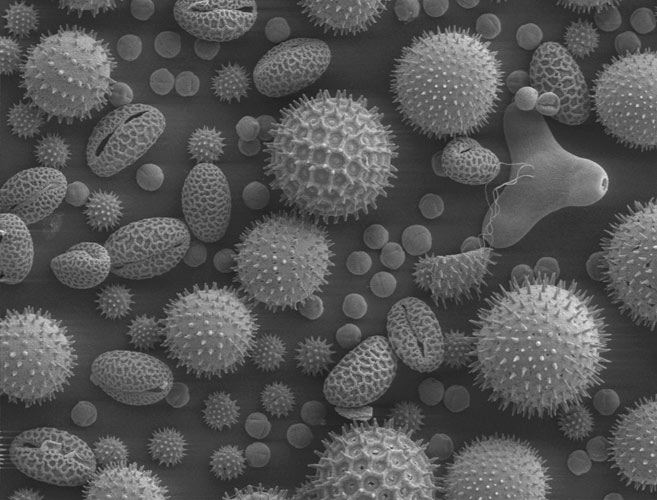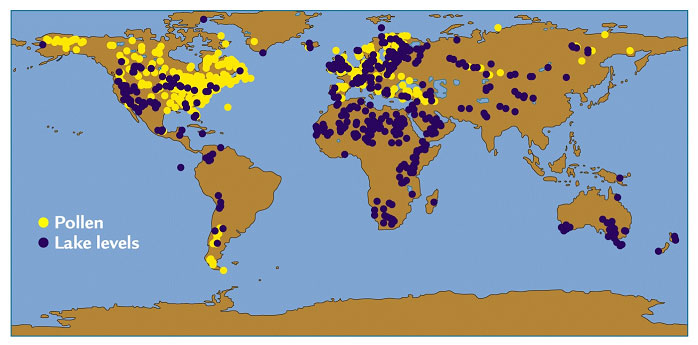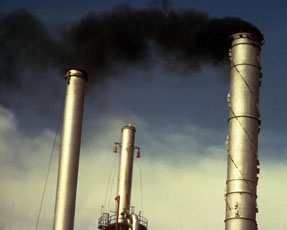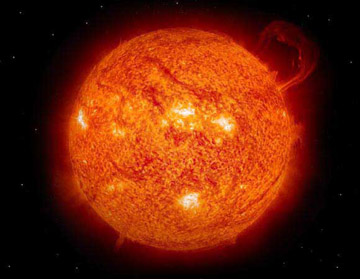Pollen: More Than Just an Allergen
Spruce trees are uncommon in Panama, while coconut palms are exceedingly rare these days in Alaska. The types of plants found in a given locale can tell us much about the climate of the region. A cactus is right at home in an arid desert, while many other species of plants are more characteristically found in the wet environment of a tropical rainforest. As local and global climates change over time, so too do the plant species that grow in specific places.
Plants emit copious quantities of pollen as part of their reproductive cycles. Pollen grains are incredibly tough and hardy, and are difficult to destroy by either physical or chemical processes. The plentiful and hardy nature of pollen makes it a rich source of data about past climates in specific places. Pollen washed into lakes via streams or carried over water by the wind accumulates in the layered deposits of sediment on lake beds. Pollen extracted from core samples of lake sediments is an important paleoclimate proxy. When viewed with a microscope, tiny pollen grains from different plants have distinctive appearances, allowing the pollen to serve as "fingerprints" of the plant species from which they were emitted.
|
This image from an electron microscope shows pollen from various common plants, including sunflowers, morning glories, hollyhocks, lilies, primroses and caster beans. Note the distinctive appearances of the various types of pollen, which allow scientists to identify the plants found in a certain place at a given time. The image is about 570 microns across. Credit: Chuck Daghlian and Louisa Howard, Dartmouth Electron Microscope Facility. |
The resolution of the proxy record presented by pollen depends on the resolution of the deposits in which the pollen is found. Lake sediments, which often have annual layers that provide a resolution as fine as a year, are the most common sources of pollen data. Pollen is also found in ice cores, which typically have an annual resolution, and seafloor sediments, which tend to have somewhat lower resolution. Whenever possible, paleobotanists try to correlate pollen records with plant fossils (of leaves, stems or trunks, seeds or pinecones, etc.) found nearby to ensure that the pollen in a deposit was not carried in from afar on the wind. Pollen counts tell us both the types of plants that grew in an area and the relative abundance of each plant species.
Although pollen can be found in sediments from the very distant past, the effective span of the climate record that can be inferred from pollen is just a few million years. We can directly check the appearance of pollens emitted by modern plant species, matching a given type of pollen with its parent plant. As we venture back in time, modern plant species give way to their precursors, and our ability to match pollen grains with specific types of plants diminishes.
|
Yellow dots on this map indicate some of the many sites from which pollen samples have been collected for use as paleoclimate proxies. Credit: National Oceanic and Atmospheric Administration Paleoclimatology Program/Department of Commerce. |
To look at the "pollen history" of a lake, scientists collect long cores of lake sediment, using tubes approximately 5 centimeters (cm) in diameter. The cores can be 10 meters long or longer, depending upon the age of the lake and amount of sediment that's been deposited. The removed core is sampled every 10 to 20 cm and washed in solutions of very strong, corrosive chemicals, such as potassium hydroxide, hydrochloric acid, and hydrogen fluoride. This harsh process removes the organic and mineral particles in the sample except for the pollen, which is composed of some of the most chemically resistant organic compounds in nature. Microscope slides are made of the remaining pollen and examined to count and identify the pollen grains.
Because every plant species has a distinctive pollen shape, botanists can identify from which plant the pollen came. Through pollen analysis, botanists can estimate the composition of a lake area by comparing the relative amount of pollen each species contributes to the whole pollen sample. Carbon dating of the lake sediment cores gives an approximate age of the sample.
















